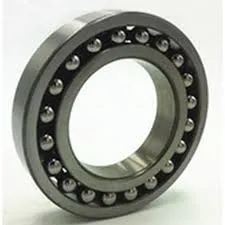
Dec . 17, 2024 21:00 Back to list
Guidelines for Proper Installation of Spherical Roller Bearings in Industrial Applications
Spherical Roller Bearing Installation A Comprehensive Guide
Spherical roller bearings are widely used in various applications, thanks to their ability to accommodate misalignment and handle both radial and axial loads. The installation of these bearings is crucial for ensuring their optimal performance and longevity. This article will provide a comprehensive overview of the steps involved in the proper installation of spherical roller bearings, focusing on best practices and common pitfalls to avoid.
Understanding Spherical Roller Bearings
Before delving into the installation process, it is essential to understand the structure and function of spherical roller bearings. These bearings consist of outer rings, inner rings, and spherical rollers, which allow for significant angular misalignment. This design enables them to handle heavy loads and operate smoothly even under challenging conditions.
Preparation for Installation
1. Inspection of Components Before installation, inspect the bearing and related components for any signs of damage or wear. Verify that the parts are the correct specifications for your application, including inner and outer diameters, width, and load capacity.
2. Cleanliness Ensure that all components, including housings and shafts, are clean and free from contaminants like dust, dirt, or grease. Use lint-free cloths and appropriate solvents to ensure that all surfaces are spotless.
3. Tools and Equipment Gather all necessary tools, including bearing pullers, hammers, installation sleeves, torque wrenches, and measuring tools. Having the right tools ensures that the installation process runs smoothly and minimizes the risk of accidents or damages.
Steps for Installation
1. Bearing Heating For easier installation, heat the spherical roller bearing before fitting. This can be done using an induction heater or an oven. The recommended temperature for heating is typically around 80-100°C (176-212°F). Avoid overheating to prevent damage to the bearings.
2. Preparing the Shaft and Housing Apply a thin layer of clean oil on the shaft and inside the bearing seat. This can help facilitate smoother installation and reduce friction between surfaces.
spherical roller bearing installation

3. Mounting on the Shaft When installing the inner ring onto a shaft, it is crucial to support the outer ring to prevent it from rotating. Use an installation sleeve to gently press the inner ring into place. Avoid impact forces that may damage the rollers or races.
4. Mounting in the Housing After the inner ring is securely mounted, the outer ring should be fitted into the housing. Again, use the installation sleeve and ensure that the bearing is pressed straight to avoid misalignment.
5. Alignment Check Once the bearing is in place, check for proper alignment. Misalignment can lead to premature bearing failure. It is vital to ensure that the bearing is seated correctly in both the housing and on the shaft.
Post-Installation Procedures
1. Sealing and Lubrication After installing the bearing, apply a suitable lubricant. Follow the manufacturer's recommendations for the type of grease or oil, and ensure that it is evenly distributed. Sealing the bearing can enhance its longevity by preventing contaminants from entering.
2. Testing Once the bearing is installed, perform a test run. Monitor for unusual noises, vibrations, or excessive heat, which could indicate installation issues. Make adjustments as necessary to rectify any problems before putting the equipment into full operation.
Common Pitfalls to Avoid
- Forcing Components Never force bearings onto shafts or into housings, as this can cause surface damage or alter the bearing's shape. - Neglecting Alignment Ensure both the inner and outer rings are correctly aligned during installation. Misalignment leads to increased wear and can significantly shorten bearing life.
- Skipping Lubrication Checks Proper lubrication is crucial for the bearing’s operation. Always adhere to the manufacturer’s lubrication schedule and use the recommended type of lubricant.
Conclusion
Proper installation of spherical roller bearings is critical to ensure their performance and reliability. By following the above steps and adhering to best practices, you can minimize the risk of installation-related issues and extend the operational lifespan of your bearings. Always consult the manufacturer's guidelines for specific requirements and recommendations tailored to your particular application. Through careful attention to detail and adherence to installation protocols, you can achieve a successful outcome and maintain the efficiency of your machinery.
Latest news
-
Premium Deep Groove Ball Bearings | High Speed & Reliability
NewsAug.29,2025
-
Durable Scaffolding Clamps - Secure & Reliable Tube Connectors
NewsAug.28,2025
-
Common Failures in Thrust Ball Bearings and Solutions
NewsAug.22,2025
-
How Tapered Roller Bearings Can Take Shock Loads
NewsAug.22,2025
-
Angular Bearings in High-Precision Spindles
NewsAug.22,2025
-
The Impact of Misalignment on Cylindrical Roller Bearing Performance
NewsAug.22,2025
